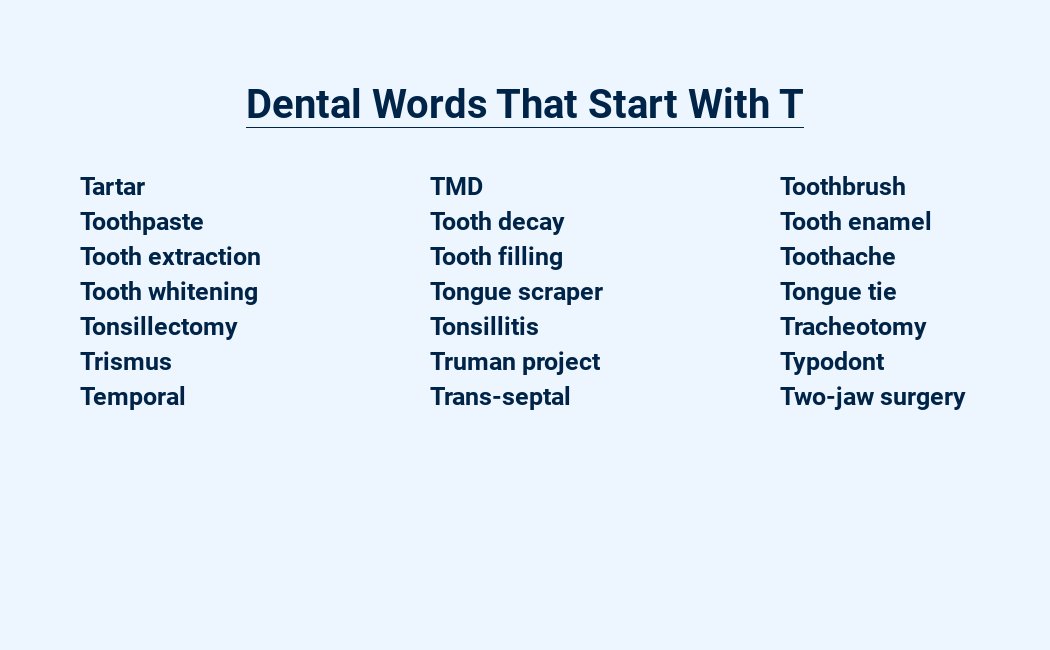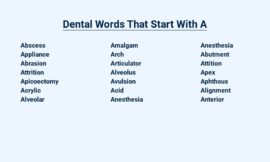Embark on a comprehensive journey through the world of dentistry, starting with the letter “T.” Discover the types of teeth, understand tooth decay and cavities, delve into tooth extraction procedures, and learn about the importance of toothpaste in maintaining oral hygiene. Explore the formation of tartar and its impact on dental health, and gain insights into temporomandibular joint disorder (TMJ).
Delve into the functions of the tongue and tonsils, and equip yourself with knowledge about toothaches and traumatic dental injuries.
| Term | Definition |
| Tartar | A hard deposit that forms on the teeth, consisting ofcalcium, phosphorus, and other minerals. |
| Temporomandibular joint (TMJ) | The joint that connects the lower jaw to the skull. |
| Toothache | A pain in the tooth, usually caused by decay, infection, or injury. |
| Toothbrush | A tool used to clean the teeth. |
| Tooth decay | The destruction of tooth tissue by bacteria, resulting in cavities. |
| Tooth extraction | The surgical removal of a tooth. |
| Toothpaste | A paste or gel used to clean the teeth. |
| Torus palatinus | A bony growth on the roof of the mouth. |
| Tongue | A muscular organ in the mouth that helps with speaking, eating, and swallowing. |
| Tonsils | Two small masses of lymphoid tissue at the back of the throat. |
Tongue: The muscular organ in the mouth that helps with speech, swallowing, and tasting.
Tooth sensitivity: A condition that causes pain in the teeth when exposed to hot, cold, or sweet foods and drinks.
Toothpaste: A paste used to clean and maintain the teeth and gums.
Tooth reshaping: A cosmetic dental procedure that involves altering the shape of teeth to improve their appearance.
Tooth replantation: The process of reattaching a tooth that has been knocked out.
Tooth reinforcement: A procedure to strengthen a weakened tooth by bonding it to an adjacent tooth or a dental post.
Tooth restoration: The process of repairing or replacing a damaged or decayed tooth to restore its function and appearance.
Tooth rotation: A condition where a tooth is twisted or turned from its normal position.
Tooth sealant: A thin, plastic coating applied to the chewing surfaces of molars and premolars to prevent decay.
Tooth setting: The process of securing a dental crown or bridge in place.
Tooth shade: The natural color of a person’s teeth.
Tooth surface: The outer layer of a tooth, consisting of enamel, dentin, and cementum.
Tooth whitening: A cosmetic dental procedure that involves bleaching the teeth to make them appear whiter.
Torsiversion: A condition where a tooth is twisted along its long axis.
Translucent teeth: Teeth that allow light to pass through them, making them appear semi-transparent.
Transposition: A condition where two teeth are switched in position.
Treatment plan: A detailed outline of the dental procedures and treatments recommended for a patient.
Trigeminal nerve: The nerve that provides sensation to the face, including the teeth and gums.
Trismus: A condition that causes difficulty opening the mouth due to muscle spasms.
Torus mandibularis: A bony growth on the lower jawbone.
Torus palatinus: A bony growth on the roof of the mouth.
Tuberosity: The rounded elevation on the back part of the upper jawbone where the maxillary molars are located.
Tufts: The small, pointed projections on the surface of the tongue that help with taste sensation.
Temporalis muscle: A muscle that helps close the jaw and move the mandible.
Temporotemporal fascia: The layer of connective tissue that covers the temporalis muscle.
Temporomandibular joint (TMJ): The joint that connects the lower jawbone (mandible) to the skull.
Temporomandibular joint disorder (TMD): A condition that affects the TMJ and causes pain, clicking, or popping sounds when opening or closing the mouth.
Types of dental crowns: Dental crowns are used to restore the shape, strength, and appearance of a tooth. Common types of dental crowns include:
All-ceramic crowns: These crowns are made entirely of ceramic material and offer a natural-looking appearance.
Metal-ceramic crowns: These crowns have a metal framework with a ceramic outer layer. They are strong and durable but less aesthetically pleasing than all-ceramic crowns.
Gold crowns: Gold crowns are made of a gold alloy and are strong and durable. They are often used for molars and premolars.
Zirconia crowns: Zirconia crowns are made of a strong, white material called zirconia. They are durable and offer a natural-looking appearance.
Dental Words That Start With T: A Comprehensive Guide
Types of Teeth
Incisors, canines, premolars, and molars are the four types of teeth in the human mouth.
Incisors are for biting, canines are for tearing, premolars are for grinding, and molars are for chewing.
Wisdom teeth are vestigial molars that may or may not erupt.
Tooth Decay and Cavities
Tooth decay, also known as cavities, is a common dental problem caused by bacteria that feed on the sugars in your mouth. This process creates acids that attack your teeth, leading to the breakdown of tooth enamel and the formation of cavities.
Tooth Extraction
Tooth extraction, also known as exodontia, is the surgical removal of a tooth from its socket in the jawbone.
It is often necessary when a tooth is severely decayed, infected, or impacted.
Tooth extraction can be performed by a dentist or oral surgeon.
Toothpaste
Toothpaste, an essential oral hygiene product, aids in the removal of plaque and food particles, preventing tooth decay and gum disease.
With various flavors and formulations, it helps freshen breath and maintain a healthy smile.
Tartar
Tartar, also known as dental calculus, is a hard, calcified deposit that forms on the teeth.
It is composed of minerals, bacteria, and food debris.
Tartar can cause gum disease, tooth decay, and other oral health problems.
Regular brushing and flossing can help prevent tartar buildup.
TMJ – Temporomandibular Joint Disorder
TMJ, or Temporomandibular Joint Disorder, is a condition that affects the jaw joint, causing pain, clicking, and difficulty chewing. It can be caused by injury, arthritis, or clenching and grinding of the teeth.
Treatment may involve pain relievers, muscle relaxants, and jaw exercises.
Tongue
Tongue, a muscular organ in the mouth, plays a crucial role in speech, swallowing, and taste perception.
Its unique texture, due to papillae, aids in food manipulation and oral hygiene.
Understanding the tongue’s anatomy and functions is essential for maintaining good oral health.
Tonsils
Tonsils are small masses of lymphoid tissue located at the back of the throat.
They play a role in the immune system by trapping and filtering bacteria and viruses that enter the mouth.
In some cases, tonsils can become infected or enlarged, leading to discomfort and health problems.
Toothache
Toothache, a common dental ailment, arises from various causes like tooth decay, infection, or injury. It can range from mild, throbbing pain to severe, sharp agony.
Treatment options include pain relievers, antibiotics, root canals, or tooth extraction.
Seeking prompt dental attention is crucial to alleviate pain and preserve oral health.
Traumatic Dental Injuries
Traumatic dental injuries are often caused by accidents or sports injuries.
They range from minor chips and cracks to more serious damage like knocked-out teeth or jaw fractures.
Early evaluation and treatment are essential to prevent long-term complications.
Final Verdict
The realm of dentistry encompasses a diverse array of terms beginning with the letter “T.” From incisors, canines, and molars, the types of teeth play crucial roles in oral health. However, tooth decay and cavities necessitate attention to prevent further damage.
In severe cases, tooth extraction may be necessary.
Maintaining oral hygiene includes regular brushing with toothpaste, preventing tartar buildup, and addressing issues like TMJ and tonsils. Moreover, addressing toothaches promptly and seeking treatment for traumatic dental injuries are essential aspects of maintaining a healthy smile.
By understanding these dental terms and their significance, individuals can better comprehend and communicate about their oral health needs.




